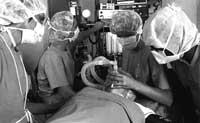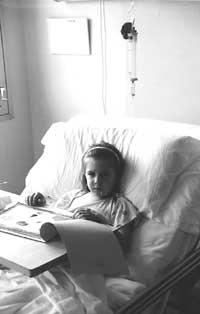Hospital infections
Why are there so many hospital infections?
The first thing to keep in mind is that people who are in the hospital, in most cases, are at higher risk for infection, because being sick and weakened by itself, can more easily run over some things. Therefore, the first thing to think about is that, above all, people are spread fairly precarious in defense. Another extreme case may be that of those who are in good condition and suffer some infection. For example, those who are going to remove a simple hernia or perform a small surgical job can also catch something at that time, as therapeutic systems can facilitate the appearance of a new infection. In this case, it is clear that if they were on the street they would have no problems.

According to statistics, about 5% of those admitted to hospitals suffer from some small infection. The most common infections are those of the urinary and respiratory system, as a consequence of the introduction of some urinary probe in the urinary tract and nosocomial pneumonia derived from interventions in the respiratory system. These are the most common. These infections penetrate through vascular devices and microorganisms may spread to the entire body or remain in a certain place. Depending on this, the infection can be more or less severe.
Returning to the statistics, it should be noted that 1% of the infections that are captured in hospitals are potentially dangerous, since in most cases they are infections that have a serious problem.
Is this a matter of responsibility for doctors?
Of course, people die and the expenses go up.
And is there something organized to fight it? It is known that medicine has advanced a lot, but is it invested in it?
Well, in each hospital there is an infection committee. The work of this commission is to carry out a general monitoring of the issue and to guide the general policy or regulations. On the other hand, the services of hospital microbiology and preventive medicine carry out the monitoring of all the procedures, of the anti-infectious measures adopted and, of course, of all the microorganisms that are isolated. These services, in the area of infection, can be considered as supervised hospitals.
In the United States, for example, for the hospital to be able to access accreditations it is necessary that there be such commissions. These types of commissions must present an annual plan, establishing procedures and establishing standards for each task, adopting anti-infectious measures in all areas (where and how hands should be washed, operating room situation, work in special care units, etc. ). In addition, they establish the policy of use of antibiotics, since it is not possible to use any antibiotic, since microorganisms generate resistance. Finally, they must also establish a maintenance policy for the installation, such as air conditioning or water traffic. As in the United States, there are also commissions of this type, currently active.
At present there is a great concern in our environment and in the world about the entry of air conditioning in operating rooms and Intensive Care Units, and at this time in Osakidetza are also making changes. Significant improvements have been made in both operating rooms and intensive care units.
So what happens? Can infections be due to malfunction?
You have to realize that there are many different microorganisms and they can also enter many ways. For example, Staphylococcus microorganisms are very frequent, an endui can peacefully enter a hospital's Intensive Care Unit and infect patients there, which may be because the procedures to prevent infection have not been adequate. But it can also happen. For example, gram-negative bacilli (pseudonyms), well known, normally live with us, are saprophytes or diners and may be in our mucous membranes, intestines or nose. We can transmit them at any time and create infection.
Fungi would enter another section. The fungus Aspergillus that has recently made us unfortunately famous does not live with us, but among us. There are many mushrooms and they can be in all kinds of places humble or broken, that is, in walls, tools, manure... They are able to cause infection at the right time.
We have to go back to an account you mentioned above. He has talked about antibiotic policy and it seems that changes in the human immune system are occurring lately due to the use of antibiotics.

Antibiotics have no immune effect. Antibiotics kill microorganisms and help natural immunity fight them, but they have nothing to do with immunity. What happens is that microorganisms are learned and adapted. With an example we will understand it better. Remember penicillin. A few years ago penicillin served for everything, today it is useful for little because they have adapted to the microorganism. With its use, microorganisms are selected slightly but are accustomed. The misuse of antibiotics in hospitals makes them useless due to the ability of microorganisms to develop the defense system. Antibiotics should be used rationally, not by taking broad spectrum antibiotics, but by selecting them.
He mentioned it in hospitals. What if microorganisms in hospitals have developed better defenses?
It's a good question. High resistance microorganisms can be everywhere, both inside and outside hospitals. It is true that the greatest selection is produced by use, but not only in hospitals, but also in primary services such as ambulatories. However, hospital microorganisms are stronger than the rest. For example, there is a variety of Staphylococcus, very resistant… if that enters the Intensive Care Unit, it is over!
In the interview he mentioned more than once the Intensive Care Unit. Is there any special reason for this? Do all hospital areas have the same risk?
No, they don't have the same risk. It is clear that people with more serious diseases are the most likely to get an infection, since it is not the same a surgical intervention with resonance that a surgery with a large incision. To somehow answer your question, we can cite the most common places to get an infection in hospitals: Intensive care units, due to the vulnerability of residents. Operating rooms, distinguishing between those requiring difficult surgical interventions and those requiring secondary interventions. Places of hemodialysis due to the particular risk; for years the most beautiful field of hepatitis has been this type of plantations, which have been repeated on several occasions.
Apparently, better stay at home than go to the hospital?
It is clear that nobody goes to the hospital at ease, but you have to go. We have to take into account – and point out clearly – that, on the one hand, infections only occur if they are given the opportunity and medicine is being worked on reducing the pathways of infection. On the other hand, although we can think of something else as seen in the media, we will provide a statistical data that shows us the progress that is being made in this area: in the last 10 years the number of hospital infections is 6% and previously we were around 9-10%. I think that shows that the risk of infection is decreasing.
Nosocomial infections
… Special circumstances in hospitals facilitate and not rarely the appearance of serious infections. First, it is necessary to take into account the intrinsic factors, that is, the basic state of the patients, which allows to develop infections. Secondly, attention should be paid to external agents that are used to perform diagnoses (endoscopies), surgical interventions (surgical interventions and prostheses) and monitoring operations (probes, pipes…). The third factors to consider, along with air pollution, are the failures in designs and facilities, especially when it comes to water and air conditioning circuits. This has led to the worldwide plagues of Legionella neumophila, for example. Finally, we should mention the misuse of antimicrobes, since they have created microorganisms capable of resisting antibiotics, such as the appearance of very rare germs at the time, the transformation of other very abundant that have become powerful, such as the microorganisms Acinetobacter or S. aureus.
The mortality rate derived from the aforementioned processes and the enormous expenditure they entail, led us to become aware of the problem in the 1960s. Years later, experience in large hospitals in the United States, with the creation of specialized groups to monitor and control nosocomial infections, demonstrated the effectiveness of various measures and decreased the number of infections by around 30%. Here also groups were organized to work gradually in the field of infections and preventive medicine.

Measures were taken to reduce urinary tract infections, measures to reduce respiratory infections in intensive care units, severe aseptic measures, study of air and water circuits, tests of appropriate surgical techniques, etc. As a result, in the period 1990-97 the number of nosocomial infections decreased from 9.87% to 8.08%.
In the case of Aspergillus, the importance of the subject is above all qualitative, since it has produced irreversible consequences. For this reason, it is not enough to reference the quantities since the deficiencies in the control systems can be hidden. If it is proven that the failure in recent infectious outbreaks has been a quality control, it must be studied in depth.
Although in some places the mentioned infections occur, compared with other countries it cannot be said that in our case the risk of nosocomial infections is higher. In fact, in several hospitals in the United States, tuberculosis pests have recently occurred and they have had to take isolation measures that we have been taking here for a long time.
Possible hospital infections need to be monitored and monitored strictly. But this requires resources with sufficient numbers of doctors and nurses in the field, along with awareness of the problem, not only of health professionals but also of the Administration, to definitively put the necessary and absent resources. There is no better quality control more effective than solving normal and abnormal health problems.
Taken from the electronic magazine Jano





